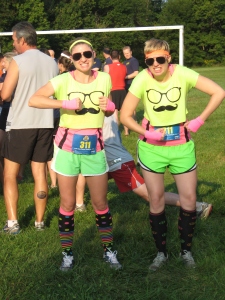Sep 19, 2012

Solidarity athletes intimidating the competition with liberal use of neon.
Strength:
Back Squat 3×5 (+1-5#)
Deadlift 1×5 (+5-10#)
Conditioning:
3 rounds:
1a) 12 knees to elbow. rest 30 seconds
1b) 12 ring rows, rest 30 seconds
1c) 12 good mornings, rest 30 seconds
1d) 20 heavy lunges (10L/10R), rest 30 seconds
Sep 17, 2012
Mobilize: Shoulders
Strength: Press 3×5 (+1-5#)
Conditioning:
For time:
Run 400m
7 rounds of:
- 5 pull ups
- 7 push ups
- 9 air squats
Run 400m
Sep 16, 2012
Strength: Back Squat 3×5 (+5#)
Conditioning:
4 rounds for time:
- 20 Kettlebell swings
- 100m farmer’s walk
1 burpee penalty every time you break on the KB swings or set the jerry cans down during farmer’s walk. Complete burpees at the end of the workout.
Sep 14, 2012
We are meeting at 10:00 a.m. at Forest Hills park.
Skill: Review push press
Conditioning:
3 rounds for total repetitions, with a continuously running clock:
- 1 minute dumbbell push press
- 1 minute bench jumps
- 1 minute burpees
- 1 minute rest
Sep 13, 2012
“Strength is the most general adaptation. It is acquired most effectively through exercises that produce the most force against external resistance, and as such is always best trained with five or six basic exercises. The same exercises that are correct for weak football players and lifters are correct for weak volleyball and baseball players, because the best way to get strong will always be the same. Strength is NOT specific, and cannot effectively be acquired through exercises that mimic sports-specific movements, because these movements lack the potential to produce as much force as general barbell exercises, and therefore lack the capacity to make weak athletes as strong as barbell training. There are tens of thousands of Physical Therapists that do not understand this simple fact, and many of them have written books. Thus, your confusion.” – Mark Rippetoe

